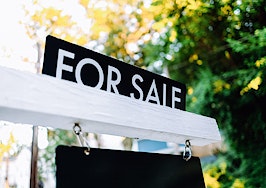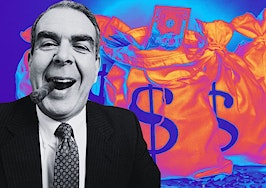This report is available exclusively to subscribers of Inman Intel, a data and research arm of Inman offering deep insights and market intelligence on the business of residential real estate and proptech. Subscribe today.
A year ago, Alexa Adams was down to the last straw.
The 35-year-old non-profit fund development professional had spent her 20s and early 30s paying “an obscene amount of rent” for apartments in the Bay Area not far from where she lived in Sacramento. Ready to live alone and build long-term wealth, Adams threw herself into California’s wily real estate market with the help of her parents, who contributed to a $141,000 down payment fund.
She closed on her home in October 2022 and intended to supplement her monthly housing costs by renting a second bedroom to medical students and traveling nurses. However, her plan hasn’t panned out.

Alexa Adams
“It’s been financially stressful,” she said, noting she spent $75,000 in housing costs over the past year. Only $40,000 of that total was accounted for by mortgage payments.
She said her parents still assist her, and skilled family members and neighbors have helped her with minor repairs.
“Everyone was very excited and gung-ho for me to buy a home, but I guess I wish people would have been a little bit more straightforward about the hardships,” she added. “As I moved in, things started to break. The cost of utilities has been one of the biggest shockers, and there’s inflation, too. I feel like everyone is struggling right now because the cost of living has gotten so high over the past year.”
Nerdwallet Home & Mortgage Expert Holden Lewis told Intel the typical homebuyer is well aware that a home transaction will be the most expensive purchase they’ll likely ever make. However, an Intel review of the true cost of homeownership in the U.S. details the extent to which the boom in rates and median home prices has raised the price of entry into the U.S. housing market.
The median existing-home price in September 2019 was $271,500. A typical 6 percent downpayment was $16,290, and the median monthly mortgage payment on a loan with a 30-year fixed rate of 3.61 percent was $1,174, Lewis said.
As of August 2023, the median existing-home price is $407,100 and the interest on a 30-year, fixed-rate mortgage is 7.16 percent. Those two metrics resulted in a typical down payment of 6 percent increasing to $24,426 (up 50 percent) and the median mortgage payment skyrocketing to $2,614 a month (up 123 percent).

Marian McPherson | Inman
“Comparing the market right before the pandemic and now, the rise in [mortgage rates and home prices] alone are killing people,” he said. “There’s a huge difference between what [2019’s] buyer and today’s buyer is facing. What it takes to save up for even a small down payment and then principal and interest [for a monthly mortgage payment] has rocketed.”
But that’s only scratching the surface of a housing affordability problem that reaches deeper into people’s pocketbooks than most consumers realize at the outset.
The sneaky costs of homeownership
Lewis said today’s new homeowners face further sticker shock when they begin accounting for up-front costs like moving costs, appliances, and furniture, plus recurring costs such as insurance, property taxes, utilities and home maintenance and repairs.
Consumers also often have to face the music when they eventually refactor in the cost other major purchases they delayed during the home-financing process, such as buying a new car. And no one has been immune from the rising cost of living due to general consumer-goods inflation.
Home insurance has increased 21 percent since last year and utilities have increased 10 percent over the same time. The cost of household goods has risen 50 percent since 2020, and inflation, although down from last year’s high of 9 percent, is still at 3.5 percent — a considerable amount above the 2 percent the Federal Reserve has been striving for.
In total, a new homebuyer purchasing a median-priced home — $407,100 — can expect to spend approximately $130,000 in their first year of homeownership:
- a current median downpayment of 14 percent — $56,994
- median monthly mortgage payment — $2,614 per month, or $31,368 per year
- median closing costs — $12,213
- median property taxes — $4,071
- median home insurance — $1,428
- median utility costs — $5,151.96
- median maintenance — $2,467
- median home furnishing expenses — $16,000
Of course, these totals vary by market and can be lowered through guidance from savvy real estate professionals who can help buyers buy down mortgage rates, find loan products with low down payment requirements and garner seller concessions at closing.
“Homebuyers are aware of the difficulties of saving for a down payment or securing a mortgage, but they may not be aware of home insurance costs or homeowners’ association fees,” Lewis said. “Buying a home is complicated and requires [buyers] to really think everything through. That’s where it really helps to have a straight-shooter real estate agent who’s going to be candid about those costs.”
Here’s a brief breakdown of what today’s consumer is shelling out:
![]()
What about the 20 percent? Down payments, closing costs and reserves
The first hurdle homebuyers must clear is saving for the initial costs associated with purchasing a home such as a down payment, closing costs, and mortgage reserves.
The golden amount for a down payment is 20 percent of the total purchase price, which is the percentage needed to avoid mortgage insurance on a conventional loan. Homebuyers who use a Federal Housing Administration (FHA) loan are required to pay up-front and annual mortgage insurance, even if they offer 20 percent down.
However, most first-time homebuyers don’t have the capital to offer a 20 percent down payment, which would clock in at $81,420 based on the latest NAR existing-home sales data.
In its 2023 annual down payment study, real estate marketplace RealtyHop brought the dilemma down to the local level and calculated how long it would take the typical homebuyer in the nation’s 150 largest metros to save a 20 percent down payment for a median-priced home in their market.
The typical homebuyer in Glendale, Calif., had the longest timeline, with it taking 15.3 years to save $225,000 for a 20 percent downpayment on a median-priced home of $1.125 million. Meanwhile, the typical homebuyer in Detroit would need 2.56 years to save $17,780 for a median-priced home of $88,900.

Chart by Daniel Houston
Thankfully, homebuyers using FHA loans are able to offer as little as 3.5 percent down if their credit scores are 580 and above; however, the threshold increases to 10 percent for borrowers with scores under 580. Homebuyers using Veteran Affairs-backed loans can offer zero down as long as the sales price isn’t higher than the home’s appraised value and have the added benefit of no private mortgage insurance (PMI) or mortgage insurance premiums (MIP). Meanwhile, conventional loan lenders set their own terms.
Sixty-two percent of all homebuyers in 2022 relied on conventional loans, 17 percent of buyers relied on FHA loans, 12 percent relied on VA loans, and 10 percent didn’t know what loan they used or used another loan option. Conventional loans held their place as the most popular loan option for each age group, although homebuyers aged 43 to 57 were most likely to use FHA loans (29 percent), a NAR study revealed.
The lowest down payment requirement for a conventional loan is 3 percent; however, lenders like Rocket Mortgage, United Wholesale Mortgage and Zillow have whittled qualifying borrowers’ out-of-pocket costs to 1 percent through a grant of 2 percent, which is applied to closing costs at closing.
Fannie Mae and Freddie Mac are the forerunners of these programs, as their HomeReady and Home Possible loans enable borrowers making less than 80 percent of their neighborhoods’ median income to obtain a conventional loan with just 3 percent down. The three percent down can come from a variety of funding sources, including family members, employer-assistance programs, and secondary financing.
These programs whittle the down payment on a median-priced home down to $4,071.
“For those who can afford higher rent payments but have been held back by the upfront costs associated with homeownership, down payment assistance can help to lower the barrier to entry and make the dream of owning a home a reality,” Zillow Home Loans Senior Macroeconomist Orphe Divounguy told Inman in August.
While there are homebuyers who operate on the extremes of the down payment spectrum, NAR’s 2023 Home Buyers and Sellers Generational Trends report shows the majority of homebuyers landed in the middle.

Source: NAR’s 2023 Home Buyers and Sellers Generational Trends
The median down payment for all homebuyers was 14 percent. However, when divided by age, homebuyers aged 24 to 32 had the smallest median down payment (8 percent), while homebuyers aged 77 to 97 had the largest median down payment (27 percent).
Divounguy said understanding what’s expected for a down payment and closing costs (e.g. appraisal fees, attorney fees and escrow funds) are the first major hurdle buyers must clear, and roughly 20 percent of them have no idea what their options are.
“Research shows that one in five [buyers] don’t even know how much to bring to the table for the down payment, and the number is even lower for closing costs,” he told Intel. “I think a lot of people go out there, and even the ones that I’ve managed to save up for a down payment are surprised to find out they need to come out of pocket for closing costs, which are approximately 3 to 6 percent of the loan amount.”

Dr. Orphe Divounguy
Median closing costs vary wildly from state to state, according to the latest Rocket Mortgage data. Missouri has the lowest median closing and transfer tax cost of $2,061. Meanwhile, homebuyers in Washington, D.C., can expect to pay a median of $29,888 for closing and transfer tax costs — a whopping 93 percent more than homebuyers in Missouri.
Sellers can cover a portion of a buyer’s closing costs; however, there are limits based on the down payment and loan type. FHA loans have a maximum seller contribution of six percent, VA loans have a maximum contribution of four percent, and the maximum for jumbo loans varies based on the lender.
For conventional loans, buyers who offer a down payment of 25 percent or more can ask a seller to cover up to 9 percent of closing costs. The maximum for buyers with down payments between 10 and 24.99 percent is six percent, and the maximum contribution for down payments below 10 percent is 3 percent.
“Let’s say that you take out a conventional loan worth $200,000. If it’s a conventional loan and you made a down payment of less than 10 percent, the seller could only contribute a maximum of 3 percent ($6,000) toward your closing costs,” a Rocket Mortgage explainer read. “These limitations help prevent fraud.”
Buyers must also consider title insurance, which can range anywhere from $500 to $3,500 in a one-time fee paid at closing. Buyers must purchase lender’s title insurance, which protects the lender in the event that the seller was not legally able to transfer the title of ownership rights. It’s suggested they purchase an owner’s policy after closing, in case unpaid property taxes, outstanding liens or fines for code violations are discovered after closing.
Finally, homebuyers must also demonstrate to the lender that they have extra reserves, which are the liquid assets they have left after the down payment and closing costs. Borrowers with lower credit scores may be required to have six months’ worth of expected mortgage payments in a savings account, while borrowers with higher scores and down payments may not have that requirement at all.
“I generally tell people to have at least six months of mortgage payments in the bank,” New American Funding executive Scott Sheldon told Bankrate. “This can be money that’s cumulative across their bank, stocks, bonds and even IRA funds.”
Divounguy said the upfront costs of homeownership are often overwhelming for homebuyers, but a mortgage professional can help demystify the process.
“The first step is always should always be to finance first, and working with a mortgage professional will make you aware of all of these costs,” he said. “They’ll even help you get your credit score in a good enough place in order to qualify for a much lower interest rate, which will save you thousands over the life of the loan.”
 Beyond the principal and interest: A full look at monthly mortgage costs
Beyond the principal and interest: A full look at monthly mortgage costs
Holden, Divounguy and Redfin Chief Economist Daryl Fairweather said the affordability of monthly mortgage payments is far from being a new issue, as the U.S. housing market has struggled to adequately close the gap between supply and demand since the Great Recession.
“You can’t talk about the cost of homeownership going up without starting with the fact that family formation in the U.S. has outpaced the pace at which we build homes in this country,” Divounguy said. “We’ve been underbuilt for over 15 years. Before the pandemic, the country was short roughly 3.8 million homes.”
The post-recession supply squeeze has contributed to higher median home prices, and in turn, higher mortgage costs for the typical buyer well before the pandemic.
From January 2009 to January 2019, the median home price increased 45 percent from $170,300 to $247,500 as home values continued to recover from the 2008 housing bust. Mortgage rates for 30-year fixed-rate loans bounced between the 3 to 5 percent range throughout the decade, with the median mortgage payment in 2009 clocking in at $1,075 as mortgage rates reached an average of 5.38 percent. By 2019, rates had slid to an average of 4.13 percent, but the rise in home prices bumped the median mortgage cost to $1,609 — a 49 percent increase from 2009.

Daryl Fairweather
That rise in median mortgage costs has only accelerated since 2019, as an early-pandemic buying frenzy accelerated home price growth and the Federal Reserve’s inflation policy has led to a quickfire rise in mortgage rates. Those two factors resulted in the typical mortgage payment for a 30-year fixed-rate mortgage reaching $2,823 in the first quarter of 2023 — a 75 percent increase from 2019.
Fairweather said Redfin’s latest data shows the median monthly mortgage payment is $2,661, a 12 percent increase from last year alone. She said data on median monthly payments often excludes home insurance and property tax costs, which vary wildly from state to state.
“Insurance premiums have increased 21 percent since last year,” she said. “So it’s not just mortgage payments going up. It’s also insurance costs.”
Fairweather blamed climate change for the boom in insurance premiums as State Farm, Allstate, and other popular insurers refuse to offer new policies in California, Florida and Louisiana, all of which experience devastating weather events multiple times a year. In her latest Forbes op-ed, she wrote that Floridians have faced a 35 percent jump in premiums, the largest increase in the nation.
“As climate change increases the severity and frequency of natural disasters, more homeowners and homebuyers will likely lose coverage or face increased insurance costs,” the article read.
Holden said home insurance costs “can be a really nasty surprise” for buyers as annual costs can be as low as $1,200 or as high as $6,000 depending on the state and your ability to get competitive rates.
“One bit of advice is that when you’re buying a home, try to get an estimate on how much the homeowners insurance will be before you make an offer,” he said. “A lot of times people are in a hurry so they don’t consider insurance costs until after they make an offer. Depending on the premium trends in your market, insurance costs can make a home unaffordable.
“Find out as quickly as possible just to make sure you’re actually going to be able to afford this place or can actually find home insurance,” he added. “Just think of California, Florida and Louisiana. Some homeowners in those states are down to one option for their insurance.”

Chart by Daniel Houston
When it comes to property taxes, Divounguy said homebuyers need to be educated on state law to properly plan for costs. “Property taxes have a huge variation across the country,” he said. “Some of the states that don’t have an income tax, so they have very high property tax. And then some states have an income tax and so their property taxes are very low.”
With that in mind, Divounguy said most can plan to pay 1 to 2 percent of the value of the owned property, including land. Property taxes are usually reassessed each year, and can be rolled into the monthly mortgage payment. If that’s not the case, buyers pay the tax to the tax office directly.
“Anything above 2 percent is a high property tax state,” he said in reference to Connecticut, New Hampshire, Illinois and New Jersey — all of which have property taxes above two percent.
Divounguy said homebuyers can take advantage of monthly cost estimates on home search platforms like Zillow, which also include estimated costs for homeowners association fees. “People can actually go on the website and type in what it is they can afford or they want to spend on a monthly basis,” he said of Zillow’s latest search tool. ” It will show them all of the available inventory in their budget and help them see how they need to adjust.”
 Turn the lights off: The rising burden of utilities
Turn the lights off: The rising burden of utilities
Throughout the pandemic, home energy costs have steadily been on the rise. Divounguy said they’ve risen about 10 percent over the past year, with the typical homeowner paying $5,151.96 per year — roughly $429.33 per month — on utilities according to the Consumer Expenditure Survey by the U.S. Bureau of Labor Statistics.
 In their latest annual home utility study, Forbes Home said utility rates are based on state infrastructure and if they need funding to update electricity grids, power plants, water sanitation or other systems. International politics impact U.S. homeowners’ monthly costs, as a dispute with an oil-producing country could send utility prices skyrocketing due to supply issues.
In their latest annual home utility study, Forbes Home said utility rates are based on state infrastructure and if they need funding to update electricity grids, power plants, water sanitation or other systems. International politics impact U.S. homeowners’ monthly costs, as a dispute with an oil-producing country could send utility prices skyrocketing due to supply issues.
“The war [in Ukraine] caused oil prices to skyrocket from around $76 per barrel to over $110 per barrel in March 2022,” the study read. “The subsequent U.S. ban on Russian oil, which makes up 10 percent of the world’s oil supply, caused domestic energy prices to surge, according to the EDF.”
Lastly, weather trends have a considerable impact on homeowners’ energy budgets.
The U.S. Energy Information Administration‘s latest forecast predicts Americans will spend 26 percent annually more on heating oil and 15 percent more on natural gas based on current meteorological trends that show a winder colder than normal north and warmer south.
Electricity costs are expected to rise 10 percent year over year, while propane costs are projected to decrease three percent from 2022.
A significant change in expected temperature trends could accelerate or decelerate utility growth, as a winter 10 percent cooler than expected could result in a 28 percent annual increase in heating oil. Meanwhile, a winter 10 percent warmer than expected could result in an annual increase of 18 percent.
Alaska, Hawaii, Connecticut, West Virginia and Georgia have the highest monthly utility costs, with the typical Alaskan homeowner paying $569.64 per month for electricity, water, gas, internet and phone access. Meanwhile, the typical Utahn homeowner has the lowest monthly utility costs, ringing in at $345.62 per month.
“The increase in energy costs is affecting everybody,” Divounguy said.
 Preparing for the long haul: Maintenance and renovation costs
Preparing for the long haul: Maintenance and renovation costs
When it comes to home maintenance, Fairweather and Holden suggested homeowners save at least 1 percent of their home’s value each year to cover repairs and renovations. Meanwhile, Divounguy urged homebuyers to save closer to 5 percent.
“Homeowners should set aside 1 percent of the value of their home for our maintenance event every single year,” Fairweather said. “Eventually you’re going to need a new roof, you’re going to need to repair your deck or there’s going to be you know some damage to your home and you don’t necessarily want to tap your home insurance for those kinds of things. You want to keep your insurance premiums low.”
Angi’s 2022 State of Homespending Report said homeowners spent an average of $8,484 on home improvement, $2,467 on home maintenance and $1,953 on emergency repairs. Remodeling a bathroom (22 percent), remodeling a kitchen (17 percent), new interior and exterior paint (17 percent) and new windows (16 percent) are the most popular repairs homeowners have planned outside of day-to-day maintenance.
Divounguy said he’s bullish about homeowners’ ability to cover maintenance costs and make renovations this year, as inflation has slowed from 9 percent to 3.5 percent. He also cited cooling lumber futures, which had risen to historical highs in late 2021 in the face of continued supply chain issues and tariffs on Canadian softwood, a core building material.
At the peak of lumber features in Q1 and Q2 2021, U.S. homebuyers were expected to see a $36K increase in the price of an average new single-family home. Lumber futures returned to pre-pandemic prices last year, with a closing price of $432.80 per thousand board feet in September 2022. Futures are currently in the high $400s, with them barely breaching $500 over the past year.
Commodities economist Andrew Hecht said lumber futures are “highly sensitive to interest rates” and should be lower than they are now. However, strong demand has kept lumber futures at 20-year highs.
“Lumber is sitting around the $500 level despite the highest mortgage rates in years,” Hecht wrote for stock market analysis platform Seeking Alpha. “One of the reasons is the surprisingly robust demand for new homes as existing home inventories have dramatically declined.”
Although lumber futures are 66 percent below the all-time high of $1,500.50 per thousand board feet in May 2021, home improvement site This Old House said “it will be awhile” before homeowners see a difference in the cost for renovations and repairs requiring wood.
“Regarding DIY and home improvement, it may be a while before consumers see lumber prices actually bottom out and stabilize,” the article read. “While the average cost of 1,000 board feet may be dropping, those costs have to pass through several stops in the supply chain before it hits the shelves of lumberyards and home improvement stores.”
Houzz’s 2023 Bathroom, Kitchen and Renovation trends surveys show homeowners’ median spend on projects has increased between 40 and 50 percent over the past year.
The median spend on all bathroom remodels has increased 50 percent year over year from $9,000 in 2021 to $13,500 in 2022. Meanwhile, the median spend on kitchen remodels increased 40 percent year over year from $10,000 in 2021 to $14,000 in 2022. The change from 2020 to 2022 is even more dramatic — homeowners are spending a whopping 75 percent more on kitchens compared to 2020 ($8,000).
The median spend on general renovations is $22,000 — a 120 percent jump from 2021 ($10,000). Meanwhile, the median cost for the top 10 percent of renovations has declined 20 percent from $175,000 to $140,000.
Houzz VP of Industry Marketing Liza Hausman said the rise in renovation costs stems from current market conditions that make voluntary moves impossible. Instead of taking on a higher mortgage rate, homeowners are opting to make updates to their current home.
“Faced with shortages of housing stock and high-interest rates, we’re seeing homeowners update their current home to make the space more functional for the long term,” Hausman said in Houzz’s 2023 Renovation Trends report. “We’re also seeing an uptick in additions, with the vast majority of homeowners hiring professionals to achieve their goals.”
Lewis said homebuyers must also budget for furnishing their home and other big-ticket expenses, such as the cost of a new car.
HomeAdvisor said the median cost of furnishing a house from scratch is $16,000, which includes the cost of delivery ($50 to $500), appliance and furniture assembly (median of $55 per hour), and the cost of professional decor services (median of $50 per hour). From there, the typical homebuyer can expect to spend a median of $266 per month on home goods and housekeeping supplies.
“Some people get kind of caught in a bind with these expenses,” Lewis said. “While you’re in the process of qualifying for a mortgage, you don’t want to buy a car. You don’t want to charge up credit cards, so you don’t buy the furniture before you close.”













